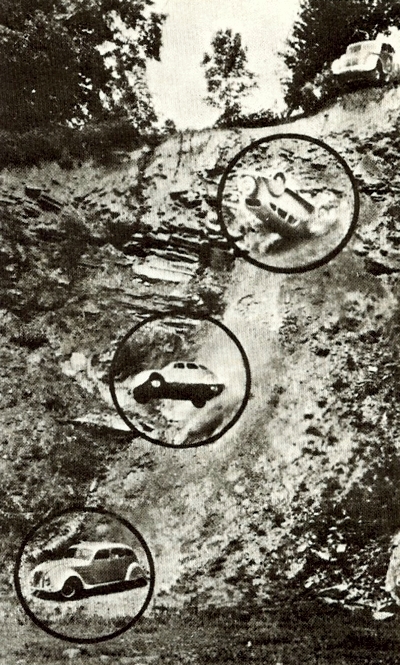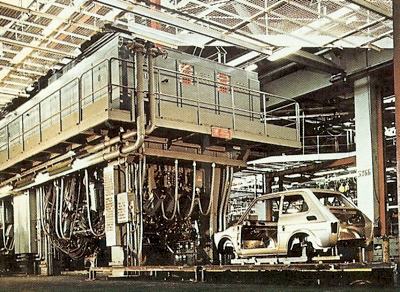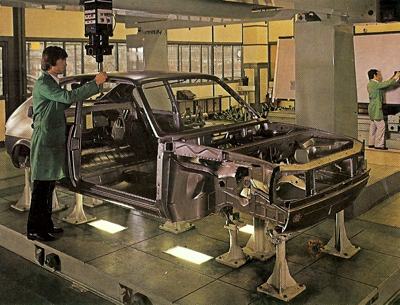From the first car, Cugnot's steam-driven Fardier of 1870, which used a frame of massive timbers with a wooden seat, it seemed to take an eternity for the basic design to develop - perhaps because there was no huge increment in speed during the first years of the
automobile. The frames of Benz's Patent carriage (1886) and Daimler's Stahlradwagen were designed simply to hold all the bits together. The very low power outputs of the early engines, in any case, rendered the addition of heavy
bodywork impracticable; performance would have been reduced to almost negligible proportions.
The Daimler Wagonette
By 1899 Daimler had produced the Daimler wagonette, a British-built car of 12 hp featuring an armoured wood chassis. The mudguards were curved strips, in the fashion of the day, with a small step attached to the chassis, anticipating the running board. At about the same time, Benz built a rear-engined 8-seater Omnibus with a 'carriage' type body. The driver's seat, however, instead of being on the roof in the style of the coachman, was at, the front, under a small canopy, surrounded by driving lamps and levers.
There is little doubt that the design and construction of these early cars owed much to the generations of coachbuilders' experience in producing horse-drawn vehicles. Bodywork was minimal and occupants were exposed to snow, rain or dust, as the weather dictated. By the early 1900s, the new science of
automobile engineering was outgrowing its dependence on carriagemakers and manufacturers of stationary engines, though it was still considerably influenced by them. Bodywork, of wood, steel and aluminium, was constructed by craftsmen to individual requirements, mechanics and
bodywork being treated as separate entities. Engine, gearbox and running gear were assembled on a chassis, which was passed to a coach-builder for
bodywork construction and fitting.
Rolls-Royce engineers were among the few who paid much attention to the bodies that were to be fitted: they demanded that the coach builder's work be of a similar standard to their own. Some owners had a selection of bodies which could be fitted; others preferred to have new bodies built. On some cars designed to the separate-body-and-chassis concept, the body could be tilted back on hinges and held up by stays. The suspension on these cars was rudimentary; designers were unsure whether the tyres, wheels, springs or the chassis should absorb the shocks. Chassis were either designed to flex; or they flexed as a result of poor design. This posed problems for the coach builders. Some designed flexible bodies, rigidly mounted to the chassis; others designed rigid bodies with flexible mountings. Occasionally, they were thwarted by a chassis that relied on the body to provide stiffening.
Edward Budd and John and Horace Dodge
Invariably, the body would work loose and squeaks and rattles would develop, and the necessary larger engine added its thumping to the other body stresses. After coachbuilt bodies of steel or aluminium panels on a wooden framework, the next phase in car body development came with the design and production of an all-steel body, In 1913 American car designers
Edward Budd and
John and Horace Dodge decided that an all-steel body was a viable proposition. They proceeded with the design and tooling up, and within three years they were producing a revolutionary, new all-steel open touring car.
By 1923, production of
Dodge all-steel motor cars had passed the million mark. In 1925, William Richard Morris (later to become Lord Nuffield) returned to England from a visit to America, inspired by the concept of an all-steel body, and applied it to his problems of large-scale motor-car production. In 1926 he, too, began the manufacture of all-steel bodies; and
automobile manufacturers in all the major European countries subsequently benefitted from American experience. The pressed steel dies and tools then in use limited the extent of the curve that the designer could obtain; as a result, many cars of that period were of a much more subtle design.
The period from 1920 to 1930 was one of the most important in the development of the steel body. In that time, welded steel bodies were produced in numbers sufficient to threaten the more traditional coachbuilding method. The pressed steel, welded form of body construction can be appreciably cheaper than the separate chassis/body structure. A long production run is necessary, however, to amortize the initial heavy costs of tooling up for this form of manufacture. (Even in the 1920s, it cost William Morris £120,000 for tooling up for his 1927 Morris Oxford body.) After the initial heavy expenditure, the cost of producing body pressings and assembling them was extremely low.
 A series of shots showing the rigorous crash testing that Budd put his cars through.
A series of shots showing the rigorous crash testing that Budd put his cars through.
 The Fiat 500 body on the assembly line.
The Fiat 500 body on the assembly line.
 Electronic measuring of the dimensions is able to determine any manufacturing errors.
Electronic measuring of the dimensions is able to determine any manufacturing errors.
|
Lancia Lambda
In contrast, coachbuilt bodies were much cheaper for a short production run but, being produced by a labour-intensive method, they were much more expensive than pressed steel, welded bodies over a long production run. Except on very expensive cars (such as Rolls-Royce), coachbuilding in its original form no longer exists. Instead, as an alternative to steel pressings, glass-reinforced plastics are used. Such material can be formed into any shape, can be strengthened simply by being thickened where extra strength is required and does not corrode. The use of glass-reinforced plastics is, however, like the production of the coachbuilt body, a, labour-intensive method and becomes more expensive than pressed-steel construction when a long production is required.
One car well known for its advanced construction was the Lancia Lambda. It had a rigid steel, integral body frame, onto which an unstressed body skin was fitted. The Lambda body frame was strong, light-weight and extremely rigid. Probably its only disadvantage was that changes in the design of the body were expensive to make; the Dilambda, which super-seded the Lambda in 1929, was designed to rest on an external chassis. The French Citroen pioneered the way for unitary body construction in 1934; the model 7A featured front-wheel drive, torsion-bar suspension and an integral pressed steel chassis and body. Although this was an unusual specification for the period, the model remained in production for over 20 years.
The Chrysler Airflow
In America, in 1934, the
Chrysler motor company produced their first
Airflow model. The appearance of this car was too unconventional for it to sell well and production was discontinued. The car had significance, however, because of its unitary construction of chassis and body. One particular point of interest about the Airflow's 'bad looks' was that it had a wider-than-normal body and no running boards, features that were later to become typical of unitary construction automobiles. The designer of an integral body shell has not only to design their car around the engine, passengers and luggage space; they must also consider the visual appeal of the body's shape. In this respect, they have to think several years ahead, knowing that the design on their drawing board will not be in production for two or three years. In this time, fashion may change dramatically.
The
Ford Edsel, one of the greatest failures of all time, was an excellent car in many respects - except for the all important one, and that is for people to actually like the design. It was withdrawn in 1959 after less than two years of production and cost to Ford of over $250 million. The little
Morris Minor 1000 is an example of an in-expensive car of the motoring-for-the-masses concept. Although its curves did not have the subtlety of a Rolls-Royce, they blended together remarkably well. This, its basic shape and the characteristic lack of embellishment placed it in a class above many others.
Safety and the Body
Passenger safety is a serious concern of body designers. Cars are now designed to crumple on impact and to absorb shock, rather than to transmit it to the occupants. During the evolution of the crumple zone, there were three types of body structure in use. One, the non-load-carrying body structure, relied on the chassis and absorbed all suspension and engine loads. This was the traditional method of construction. The semi-integral type had the chassis loading transferred to the body; the body imparted stiffness to the chassis. The fully-integral or unitary type had all the loads absorbed by the body structure. Here, the complete body shell formed the load-carrying beam as opposed to the relatively small beams of which the chassis would otherwise have been constructed. A fully integral structure is therefore stiffer, stronger and lighter than a non-load-carrying body with a separate chassis.
Unitary Construction
Unitary construction utilizes steel pressings, combining the functions of both chassis and body. The stresses in this form of construction were taken by steel panels, which are curved or creased to provide them with additional rigidity and strength, or which may be formed into bar sections. In areas where there are high stresses, there may be a double thickness of metal; or separate sub-frames, which accept high loads and distribute them over a large area of the body structure. The basic part of the unitary structure is the under-frame.
This was typically a floor pan, which incorporates mounting points for the engine, the suspension attachments and for the passenger seats. To this under frame are added the remainder of the panels and components. Variations of the unitary concept are sometimes used, notably on the
Rover 2000 which employed a complete unitary underframe and body structure but removable outer skin panels were bolted to this framework. Repairs were easily made in the event of damage and body styling changes could be undertaken easily and inexpensively. As the Rover construction concept was similar to that of the Lancia Lambda, it may appear contradictory that the Lancia was a problem to restyle and the Rover is not. The Lancia skin covered the frame, however, whereas the Rover skin was bolted to the frame and did not lie against it.
For decades American car manufacturers, confronted by the twin problems of high initial costs of unitary construction and changing fashion styles, retained the chassis. This gave them considerable flexibility in modifying their bodywork, which they were likely to do almost on an annual basis, At the same time, the chassis, which would remain in production for many years, could be modified. European manufacturers adapted to more subtle designs changes, meaning the integral body could remain in production for many more years without major modifications, The unitary construction method was, therefore, adopted in Europe long before the US.
At The Body Shop
Both unitary vehicles and those with a separate chassis and body can usually be repaired after suffering accident damage, if the damage is not too severe. Damaged parts can be re-worked into shape or replaced; or repair and renewal can be combined. It is necessary, before and after repair of a vehicle that has suffered accident damage, to measure various points on the chassis or body to check the degree of any misalignment. Each vehicle manufacturer supplies a chart that shows where measurements should be made and what they should be. The methods of measurement differ from one manufacturer to another. Some are concerned only with the alignment and position of the wheels, while others provide other measurements to check the actual
bodywork as well.
Chassis Alignment
Chassis alignment may be checked with the aid of a number of plumb-lines, attached to specified points on the chassis; the plumb-lines should align themselves with measurements made on the floor. Measurements may also be made between points on the chassis itself. Body measurements may be similarly made. There may be additional measurements from the bottom of one door pillar to the top of the other on the opposite side and vice versa. These will serve to show that the body is symmetrical. Doors, bonnets and boot lids are not measured, but, if they do not fit accurately, can be aligned by using a hammer and spoon, or the part may be bent to compensate for more severe misalignments, by means of special clamps.
Bent or twisted bodies can be adjusted by means of hydraulic or screw jacks. A twisted or bent chassis can be realigned, if it is not too severe, by either hot or cold methods, depending on the advice of the manufacturer. New chassis components may be rivetted or welded on, Body components which are damaged beyond repair may be cut out and renewed by welding.
Also see: Founding Fathers - Edward Budd |
Lost Marques - The William Morris Story


